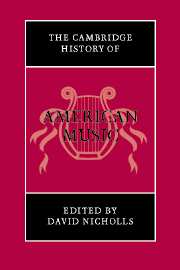Book contents
- Frontmatter
- PART ONE
- 1 American Indian musics, past and present
- 2 Music in America: an overview (part 1)
- 3 Secular music to 1800
- 4 Sacred music to 1800
- 5 African American music to 1900
- 6 Immigrant, folk, and regional musics in the nineteenth century
- 7 Nineteenth-century popular music
- 8 Art music from 1800 to 1860
- 9 Art music from 1860 to 1920
- PART TWO
- Bibliography and references
- Index
- References
7 - Nineteenth-century popular music
from PART ONE
Published online by Cambridge University Press: 28 March 2008
- Frontmatter
- PART ONE
- 1 American Indian musics, past and present
- 2 Music in America: an overview (part 1)
- 3 Secular music to 1800
- 4 Sacred music to 1800
- 5 African American music to 1900
- 6 Immigrant, folk, and regional musics in the nineteenth century
- 7 Nineteenth-century popular music
- 8 Art music from 1800 to 1860
- 9 Art music from 1860 to 1920
- PART TWO
- Bibliography and references
- Index
- References
Summary
At heart, this is a chapter about the early development of what musicologist Richard Crawford calls the music of “accessibility”, a music which seeks “most of all to find and please audiences and to increase their size” (Crawford 1993, pp. 86–88). To judge by events and developments in the nineteenth century, popular music pleased its audience by speaking directly to its needs and wishes. This chapter, then, will attempt likewise to discover and analyze audience and its concerns, in the belief that such a method leads most directly to understanding. By concentrating on reception and audience, instead of production (i.e. the performers, composers, and publishers), one hopes with Walt Whitman to find Americans – his mechanics, carpenters, masons, boatmen, shoemakers, hatters, woodcutters, ploughboys, mothers, wives, girls, young fellows – again “Singing, with open mouths, their strong melodious songs,” all “singing what belongs to [them], to none else” (from I Hear America Singing, 1860).
The range of popular music available to nineteenth-century Americans followed from developing notions of public and private spheres. Until this period, “privacy” in Western society was something unique to the few, generally those of exceptional wealth or special status. Most white Americans and their cousin Europeans of the previous centuries lived in a public world, where the individual’s primary role was the sustenance of the community. Accordingly, the music of this earlier period was almost always for public venues, whether theatres, churches, streets, or byways, for audiences that were often in some way participants as well. Communities sanctioned, varied, and sustained folk ballads; operas were social occasions; church music served to unite a congregation and bind it through ritual.
- Type
- Chapter
- Information
- The Cambridge History of American Music , pp. 158 - 185Publisher: Cambridge University PressPrint publication year: 1998

